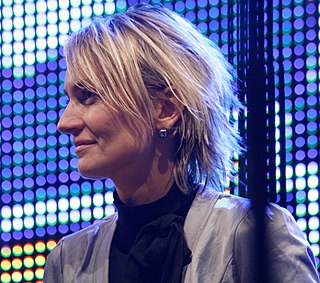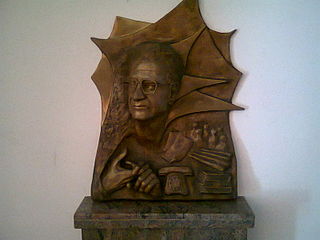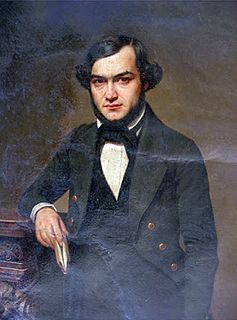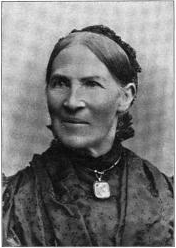 W
WFrederick Augustus Porter Barnard was an American academic and educator who served as the 10th President of Columbia University. Born in Sheffield, Massachusetts, he graduated from Yale University in 1828 and served in a succession of academic appointments, including as Chancellor of the University of Mississippi from 1856 to 1861. He assumed office as President of Columbia University in 1864, where he presided over a series of improvements to the university until his death in 1889. He was also known as an author of academic texts.
 W
WFerdinand Berthier was a deaf educator, intellectual and political organiser in nineteenth-century France, and is one of the earliest champions of deaf identity and culture.
 W
WEdith Bryan was an English teacher of the deaf, who after teaching in England and Ireland, emigrated to Australia and became one of the educators who contributed to the development of Special Education in Queensland. Though trained in the oralist tradition, she supported the use of sign language and fingerspelling for teaching purposes. From 1901 to 1926, she was the head teacher of the school operated by the Queensland Blind Deaf and Dumb Institute. An activist, she pressed for the training of special education students to become mandatory, and fought for their teachers to be paid the same salaries as other teachers. From 1926 to 1937 she taught at the Queensland school where she became responsible for the courses for deaf students. After her retirement, she volunteered at the Edith Bryan Hostel, a facility that offered housing and medical assistance to deaf citizens. She is considered to be one of the two most influential pioneers of special education in Queensland.
 W
WLouis Laurent Marie Clerc was a French teacher called "The Apostle of the Deaf in America" and was regarded as the most renowned deaf person in American Deaf History. He was taught by Abbé Sicard and deaf educator Jean Massieu, at the Institution Nationale des Sourds-Muets in Paris. With Thomas Hopkins Gallaudet, he co-founded the first school for the deaf in North America, the Asylum for the Education and Instruction of the Deaf and Dumb, on April 15, 1817 in the old Bennet's City Hotel, Hartford, Connecticut. The school was subsequently renamed the American School for the Deaf and in 1821 moved to 139 Main Street, West Hartford. The school remains the oldest existing school for the deaf in North America.
 W
WJohn Collins Covell was a 19th-century American educator and school administrator specializing in deaf education in the U.S. states of Virginia and West Virginia.
 W
WJoel Deutsch was a Moravian Jewish writer, pedagogue, and distinguished deaf educator.
 W
WJane Fernandes is a Deaf American educator and social justice advocate. As of August 2021, Fernandes is the new President of Antioch College in Yellow Springs, Ohio. She is the second woman and first Deaf person to serve as Antioch's president. In 2014, she became the first Deaf woman to lead an American college or university, serving at Guilford College through July 2021. In 1990, she became the first Deaf female to lead an American school designed for deaf, hard of hearing, blind, and deaf-blind students, serving at the Hawaii School for the Deaf and Blind until August 1995. At Guilford, she succeeded Kent Chabotar becoming the first woman to hold this position. Fernandes was formally inaugurated as the first female and the ninth president of Guilford College.
 W
WDorothy Canfield Fisher was an educational reformer, social activist, and best-selling American author in the early 20th century. She strongly supported women's rights, racial equality, and lifelong education. Eleanor Roosevelt named her one of the ten most influential women in the United States. In addition to bringing the Montessori method of child-rearing to the U.S., she presided over the country's first adult education program and shaped literary tastes by serving as a member of the Book of the Month Club selection committee from 1925 to 1951.
 W
WEdith Mansfield Fitzgerald (1877–1940) was a deaf American woman who invented a system for the deaf to learn proper placement of words in the construction of sentences. Her method, which was known as the 'Fitzgerald Key,' was used to teach those with hearing disabilities in three-quarters of the schools in the United States.
 W
WSarah Fuller was an American educator.
 W
WPierre Patrick Gorman, was an Australian librarian and academic who specialised in education for children with disabilities. Born profoundly deaf, Gorman was the first deaf person to receive a doctorate at Cambridge University.
 W
WDr. T. Alan Hurwitz is an American educator who served as the tenth President of Gallaudet University from 2010 to 2015. He is the first person born deaf, and first Jew, to hold this position. Previously, he served as President of the National Technical Institute for the Deaf and Vice President and Dean of Rochester Institute of Technology. He served in a variety of other roles for most of NTID's 40-year history.
 W
WIsawa Shūji was a Japanese educator of the Meiji period.
 W
WHelene Jarmer, as a member of the National Council of Austria, is the third culturally Deaf person in world history to be elected to a national parliament.
 W
WIrving King Jordan is an American educator who became the first deaf president of Gallaudet University in 1988 after the Deaf President Now protest. Gallaudet is the world's only university with all programs and services designed specifically for deaf and hard-of-hearing students.
 W
WSarah Warren Keeler was an American educator and teacher who founded and was Principal of a school for the deaf-mute in New York.
 W
WAadel Lampe was a Norwegian women's rights leader, liberal politician, teacher for deaf children and suffragist in the late 19th and early 20th century. She was elected as a deputy member of the Storting in 1922, as one of the first women elected to the Norwegian parliament, and served as President of the Norwegian Association for Women's Rights from 1922 to 1926.
 W
WCharles-Michel de l'Épée was a philanthropic educator of 18th-century France who has become known as the "Father of the Deaf".
 W
WJoseph Schuyler Long was an educator, author, and principal. He taught deaf children and authored the first standard picture dictionary of sign Language after becoming deaf himself as a child. He also wrote a book of poetry titled Out of the Silence.
 W
WAntonio Magarotto was an Italian educator, founder of the Ente Nazionale Sordi (ENS) and rector of the Padua Deaf institute. His son Cesare Magarotto founded the World Federation of the Deaf.
 W
WCesare Magarotto (1917-2006) was one of the founders of World Federation of the Deaf (WFD), its first General Secretary (1951–1987) and the son of Antonio Magarotto, the founder of the Italian National Agency for the Deaf (ENS).
 W
WJean Massieu was a pioneering deaf educator. One of six deaf siblings, he was denied schooling until age thirteen when he met Abbé Sicard, who enrolled him in the Institute national des jeunes sourds de Bordeaux-Gradignan, the Bordeaux School for Deaf Children. There he learned to read and write French, and later helped develop the first formalized French Sign Language. This French Sign Language was later adapted into American Sign Language. He taught at the famous school for the deaf in Paris where Laurent Clerc was one of his students. He began work after a scandal in Paris in Rodez and dedicated his life to educating deaf children. Later he founded a deaf school in Lille, France.
 W
WRobert F. Panara was a poet, a professor and a co-founder of the National Technical Institute for the Deaf (NTID) and the National Theater of the Deaf. Panara is considered to be a pioneer in deaf culture studies in the United States.
 W
WReverend Richard Aslatt Pearce (1855–1928) was the first deaf person to be ordained as an Anglican clergyman. He was educated via the sign language of his era, he became Chaplain to the Deaf and Dumb, and he fulfilled this duty in the Southampton area for the rest of his life. In 1885 he was introduced to Queen Victoria, who then ordered the Royal Commission on the Blind, the Deaf and Dumb and Others of the United Kingdom, 1889.
 W
WPierre Pélissier was a pioneer for deaf education in France in the mid 19th century. He was born September 22, 1814, in Gourdon, Lot, and died April 30, 1863. He was a teacher of the deaf and also wrote a dictionary for an early form of French Sign Language in 1856. He studied first at Rodez and Toulouse, under Abbot Chazottes. He then became a teacher at the School of the Deaf in Toulouse. He was the deputy secretary of the Central Society for Deaf Mutes in Paris in 1842. At 29, in 1843, he went to Paris to teach at the Imperial School for Deaf Mutes, until his death.
 W
WMarie Jean Philip was a leader in both the American and international Deaf community. She advocated for the right to a natural sign language for Deaf people. Marie was one of the original researchers studying ASL and Deaf Culture. She was active in establishing American Sign Language (ASL) as a recognized language in the colleges of Massachusetts in the early 1980s. Later, Marie was the Bilingual-Bicultural Coordinator at The Learning Center for the Deaf in Framingham, Massachusetts.
 W
WDom Pedro Ponce de Leon, O.S.B., (1520–1584) was a Spanish Benedictine monk who is often credited as being "the first teacher for the deaf".
 W
WÁngel Ramos is current Principal of Hawaii School for the Deaf and the Blind. He was the founder of the National Hispanic Council of the Deaf and Hard of Hearing, He was also Former Superintendent of the Idaho School for the Deaf and the Blind, Sequoia School for the Deaf and Hard of Hearing (AZ) and Marie Katzenbach School for the Deaf. He is the second deaf Hispanic/Latino to receive a doctorate degree and the first to receive a doctorate from Gallaudet University.
 W
WHedevig Rosing was a Danish-born Norwegian author, educator, school founder, and suffragist. She specialized in teaching the deaf-mute. She was the first woman to teach in Copenhagen's public schools.
 W
WRóisín Shortall is an Irish Social Democrats politician who has been joint leader of the Social Democrats since June 2015. She has been a Teachta Dála (TD) for the Dublin North-West constituency since 1992. She previously served as Minister of State for Primary Care from 2011 to 2012.
 W
WRoch-Ambroise Cucurron Sicard was a French abbé and instructor of the deaf.
 W
WRebeca Lourdes García Soundy is a Salvadoran deaf educator and YouTuber. She teaches Salvadoran Sign Language (LESSA) and American Sign Language (ASL). Her channel aims to raise societal awareness of deaf culture and sign language.
 W
WGeorge William Veditz was a former president of National Association of the Deaf of the United States and was one of the first to film American Sign Language.
 W
WLillie Eginton Warren was an American educator and an author of work upon defective speech. She was the inventor of the Warren Method of Expression Reading and Numerical Cipher. This method was a patented series of pictures of the expressions of the facial muscles produced by articulate speech by which it was possible for a deaf person to understand conversation by the eyes alone. Until the 1890s, deaf education was limited to children, but Warren and her assistant, Edward Nichie, expanded the scope of work to adults.
 W
WJoseph Watson was an English teacher of deaf children, and writer on teaching the deaf.
 W
WWilliam Willard founded Indiana's school for the deaf in Indianapolis, Indiana, which later became the Indiana School for the Deaf. He was one of the most important deaf persons in the deaf community.
 W
WBlanche Wilkins Williams was an American educator of deaf children. In 1893 she became the first African American woman to graduate from the Minnesota State Academy for the Deaf. She was described by a prominent deaf newspaper as "the most accomplished deaf lady of her race in America".